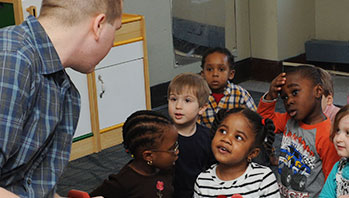- cell phone or video (optional)
- loud
- soft
- volume
MA Standards:
Speaking and Listening/SL.PK.MA.1: Participate in collaborative conversations with diverse partners during daily routines and play.
Language/L.PK.MA.1: Demonstrate use of oral language in informal everyday activities.
Head Start Outcomes:
Language Development/Receptive Language: Attends to language during conversations, songs, stories, or other learning experiences."
Language Development/Expressive Language: Uses language to express ideas and needs.
Logic and Reasoning/Reasoning and Problem Solving: Classifies, compares, and contrasts objects, events, and experiences.
Social Emotional Development/Self-Regulation: Recognizes and labels emotions.
PreK Learning Guidelines:
English Language Arts/Language 2: Participate actively in discussions, listen to the ideas of others, and ask and answer relevant questions
Talk Together: Loud and Soft Voices

© Commonwealth of Massachusetts, Department of Early Education and Care (Jennifer Waddell photographer). All rights reserved.
STEM Key Concepts: Sounds have a source; Sounds vary in three ways: volume, pitch, and timbre
ELA Focus Skills: Speaking and Listening, Vocabulary
Discuss different objects that have volume control, such as a television or car radio. Ask, Have you ever turned the sound of a television up loud? What about a car radio?
- You may wish to demonstrate different volumes with your cell phone ringer or a video.
- As you demonstrate, say, I am changing the volume of the ringer. Volume tells how loud or soft a sound is.
Ask children if they have ever been asked to “quiet down.” Then ask, When someone asks you to quiet down, what do they want you to do? (lower the volume of your voice) If they ask you to speak up, what do they want? How is it like changing the volume of the television or car radio?
- Have children practice changing the volume of their voices. Sing the morning song or any other song very quietly, then sing it a little louder, and then sing it very loudly.
- Guide children to use the word volume to talk about how they are changing their voices.
- Talk about times when you need to be loud and times when it is important to be quiet during the day.
Social Emotional Tip: Ask children how they feel when they speak loudly or speak more quietly. Say, When you speak up, how do you feel? When you talk more quietly, how do you feel? Talk about how different volumes of a person's voice can show different emotions they are feeling. (i.e., scared/loud; tired/quiet; excited/high)
